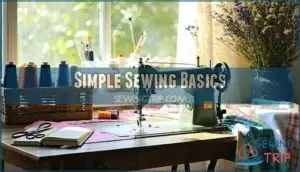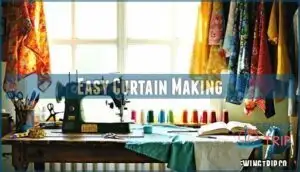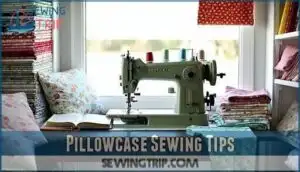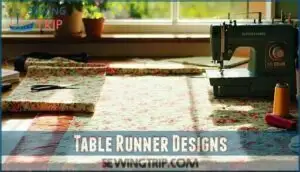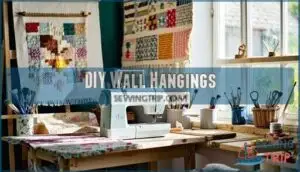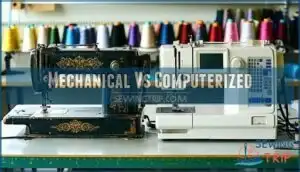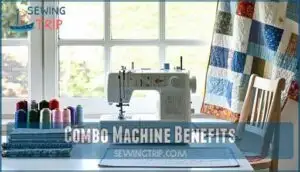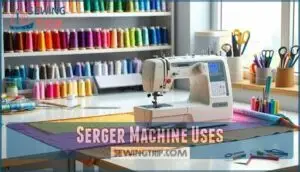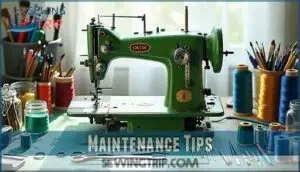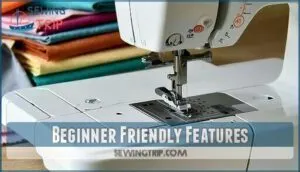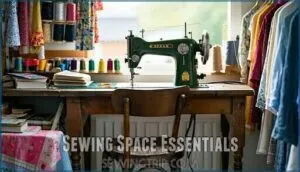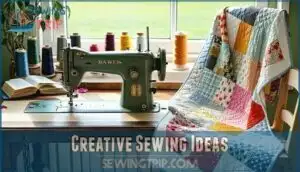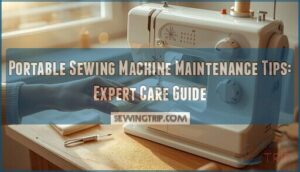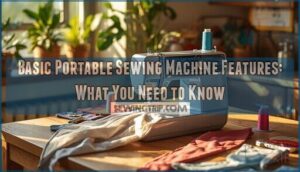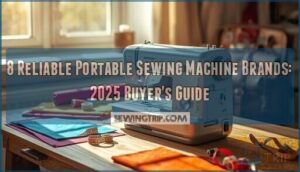This site is supported by our readers. We may earn a commission, at no cost to you, if you purchase through links.

Start with beginner-friendly ideas like sewing pillowcases, table runners, or curtains. A basic machine with features like an automatic needle threader and adjustable stitch length will make things smoother.
Use lightweight cotton fabrics—they’re forgiving and easy to handle. Add personality by upcycling old clothes into unique decor or stitching simple wall hangings.
Keep your sewing area organized with good lighting and comfy seating, so you’ll enjoy the process. With a little practice, you’ll turn plain fabrics into custom pieces that feel like home. Ready to thread the needle?
Table Of Contents
Key Takeaways
- Start with easy projects like pillowcases, curtains, or table runners to build confidence and practice basic stitches.
- Choose a sewing machine with beginner-friendly features like automatic threading and adjustable stitch lengths for smoother projects.
- Keep your sewing area organized with good lighting, proper storage, and a comfy chair to stay focused and enjoy the sewing process.
- Use durable fabrics for home decor and upcycle old materials to create unique, personalized pieces.
Simple Sewing Basics
Starting with simple sewing basics helps you build confidence and get comfortable with your machine.
From choosing the right model to mastering basic stitches, you’ll have everything you need to begin creating home decor projects.
Choosing Right Machine
When picking a sewing machine for home use, think about your skill level, space requirements, and budget considerations.
Beginners should prioritize user-friendly features like automatic threading and built-in stitches.
For home decor projects, machine durability is key to handling various fabrics.
A compact, reliable sewing machine for beginners guarantees smooth stitching without overwhelming your workspace or wallet.
Consider the machine’s ability to manage various stitch settings for customized projects.
Essential Accessories
Having the right sewing machine accessories makes every project smoother.
Stock up on sewing essentials to avoid hiccups mid-stitch.
- Presser Feet: Keep a variety for tasks like zippers or quilting.
- Bobbin Types: Use compatible bobbins to prevent jams.
- Needle Guide: Match needles to fabric for clean results.
Different projects may require specialized presser feet.
These small tools make a big difference!
Basic Stitches Guide
Every sewing project starts with mastering basic stitches.
The Straight Stitch is your go-to for clean seams, while the Zigzag Stitch handles stretchy fabrics.
For invisible hems on curtains, try the Blind Hem.
Overlock Stitch keeps fabric edges neat, and the Buttonhole Stitch is perfect for closures.
These stitch applications are essential for beginners creating stunning home decor with a sewing machine.
Threading Made Easy
Threading your sewing machine doesn’t have to feel like solving a puzzle.
Threading your sewing machine is simpler than it seems—just follow the guide arrows and let the automatic threader do the work!
Start by following the thread guide arrows, and use the automatic needle threader if your machine has one—it’s a lifesaver!
Don’t forget these essentials:
- Check thread tension for smooth stitching.
- Wind the bobbin evenly to avoid jams.
- Match needle types to fabric.
- Practice easy threading for confidence.
Home Decor Projects
You can create simple and stylish home decor projects with just a sewing machine and a bit of fabric.
From curtains to pillowcases, these beginner-friendly ideas will help you refresh your space with ease.
Easy Curtain Making
Curtains are a simple DIY home decor project perfect for beginners.
Start by measuring windows carefully, adding extra fabric for hems. Choose sturdy materials for smooth sewing.
For beginners, selecting the right fabric simplifies sewing is crucial. Use hemming techniques like folding and stitching for clean edges.
Lining options add polish, while hanging methods like rod pockets or rings complete the look. Your sewing machine makes fabric crafts effortless!
Pillowcase Sewing Tips
After curtains, handmade cushions like pillowcases can elevate your DIY home decor.
Start with these tips:
- Fabric Selection: Choose soft, durable materials for comfort and style.
- Pillowcase Sizes: Measure accurately for a snug fit.
- Closure Methods: Try envelope-style or button closures for ease.
- Seam Finishes: Use zigzag stitches or sergers to prevent fraying.
Many sewers find inspiration in available sewing patterns.
Perfect for beginner sewing projects!
Table Runner Designs
After perfecting pillowcases, table runners are a fun way to explore DIY home decor.
Focus on fabric selection and color palettes that match your space.
Try pattern matching for a polished look or add embellishment ideas like trim or appliqué.
Keep size considerations in mind for your table, as these easy sewing crafts are great beginner sewing projects with endless creative possibilities!
DIY Wall Hangings
Creating DIY wall hangings is a fun way to personalize your space after finishing table runners.
Use fabric wall art to showcase your style with these easy sewing crafts:
- Fabric Selection: Choose bold prints or upcycled fabric decor.
- Hanging Techniques: Try wooden dowels or curtain rods.
- Design Inspiration: Mix embroidery with patchwork.
- Framing Options: Add hoops or stretched canvases.
Sewing Machine Types
When choosing a sewing machine, it’s important to understand the main types: mechanical, computerized, and combo. Each offers unique features to match your comfort level and project needs.
Mechanical Vs Computerized
When tackling sewing machine decor or home sewing ideas, choosing between mechanical and computerized models matters.
Mechanical machines offer durability, simple repair difficulty, and great stitch control for a long-term investment.
Computerized ones shine with automated functions, beginner friendliness, and advanced features.
If you’re into straightforward projects, mechanical works well.
For creative stitching, computerized adds flair.
Mechanical sewing machines are known for their simplicity and affordability, making them a budget-friendly choice.
Combo Machine Benefits
If you’re torn between mechanical and computerized models, a combo sewing machine offers the best of both worlds.
It’s a versatile option that simplifies projects and expands your creativity. With features like embroidery options and adjustable settings, it’s perfect for home decor fabrics.
Plus, it saves space and money by combining functionalities. One key benefit is the ability to utilize a larger embroidery field for complex designs.
- Versatility Advantages: Handles various projects seamlessly.
- Learning Curve: Easier for beginners with guided features.
- Cost Savings: Combines tools, reducing extra purchases.
Serger Machine Uses
A serger is your go-to for clean, professional edges on handmade home goods.
It trims, stitches, and finishes seams in one pass, saving time on sewing projects.
Use the differential feed to handle tricky fabrics or try the rolled hem technique for polished table linens.
Add serger decorative stitches to fabric scrap projects for unique, personalized home decor.
Maintenance Tips
Keeping your machine in top shape is like giving it a spa day. Regular oiling, cleaning lint, and checking bobbin care improve durability.
Replace needles often to avoid skipped stitches. Tension adjustment guarantees smooth sewing, while troubleshooting common issues prevents frustration.
Follow your sewing machine warranty guidelines for repairs, and remember, proper maintenance saves time and extends your machine’s life, which is crucial for its overall durability.
Beginner Friendly Features
Beginner-friendly sewing machines make starting your projects simple with features like automatic needle threaders and adjustable stitch lengths.
These tools save time and reduce frustration, letting you focus on creating home decor you’ll be proud of with the help of adjustable stitch lengths.
Automatic Needle Threader
An automatic needle threader saves time and reduces frustration, especially for beginners.
It’s a must-have for smooth sewing projects and sewing room decor upgrades.
Enjoy these threading benefits:
- Beginner friendliness: No squinting or struggling.
- Speed improvement: Thread quickly and keep sewing.
- Threader maintenance: Clean gently for longevity.
- Threader alternatives: Manual threading works but takes longer.
This feature simplifies sewing machine use effortlessly.
Some models, like the Singer 5400, are especially popular with beginners.
One Step Buttonhole
If threading felt like a win, wait until you try the one-step buttonhole feature.
It’s a game-changer for buttonhole consistency, no matter the fabric compatibility or button size.
With buttonhole feet guiding the process, your sewing machine handles the tricky parts.
Say goodbye to uneven buttonholes and hello to polished sewing projects, from pillow covers to sewing room decor!
Adjustable Stitch Length
Adjustable stitch length is a game-changer for sewing projects.
Whether you’re working with delicate fabrics or sturdy denim, tailoring stitch density to your fabric type guarantees seam strength and durability.
It’s perfect for decorative stitches or simple sewing patterns.
Most sewing machines include this feature, and sewing tutorials often highlight its importance for meeting diverse project needs effortlessly, making it a key factor in achieving professional results with seam strength.
Free Arm Sewing
Adjustable stitches are great, but have you tried the sewing machine free arm? It’s a game-changer for circular sewing like cuffs, sleeves, or pant hems.
That awkward bunching? Gone.
- Perfect for cuff sewing and sleeve techniques
- Simplifies pant hems and small projects
- Ideal for free-motion embroidery
- Handles tricky circular sewing patterns
- Makes sewing projects less frustrating
Sewing Space Essentials
Setting up your sewing space doesn’t have to be complicated. With good lighting, smart storage, and a comfy chair, you’ll be ready to tackle any project.
Well Lit Work Area
Good lighting makes sewing easier and more enjoyable.
LED lighting is a game-changer for your sewing machine sewing space.
With proper bulb placement and cool light temperature, you’ll reduce eye strain during long projects.
Task lighting brightens your LED work area, ensuring every stitch is visible, and a well-lit sewing space keeps you focused and avoids mistakes in your creations.
Organized Storage Tips
Keep your sewing space tidy with smart storage solutions.
Try these ideas for accessory organization and fabric storage:
- Use clear bins for thread management and pattern storage.
- Hang pegboards to display sewing machine accessories.
- Roll fabrics into compact bundles for space-saving.
- Add labeled drawers for sewing machine compatible accessories.
A clutter-free sewing space boosts creativity and keeps everything within reach, making it a tidy and organized area to work in.
Comfortable Seating Options
After organizing your tools, think about seating.
An ergonomic chair with lumbar support keeps your posture in check during long sewing sessions.
Adjust the seating height so your arms rest comfortably while using the sewing machine for home use or DIY projects.
A footrest can also reduce strain.
Comfortable seating guarantees every stitch feels effortless, even on creative projects like home furnishings.
Ergonomic Considerations
Ergonomics matter when sewing! A fatigue-free design starts with proper table height and seating comfort.
Use an adjustable chair to align with your sewing machine pedal. Lighting solutions reduce eye strain, while a tilted table minimizes strain on your neck.
Posture improvement tools, like cushions or supports, and lightweight sewing machines guarantee sewing machine ergonomics that keep you pain-free and productive.
Consider using ergonomic swivel chairs for easy movement.
Creative Sewing Ideas
You can use your sewing machine to create unique and practical home decor projects with ease.
From upcycling old fabrics to adding embroidery, there’s plenty to try even if you’re just starting out.
Upcycling Old Fabrics
Turn old fabrics into treasures with creative projects that blend sustainability and style.
Start with fabric sourcing—dig through closets or thrift stores for hidden gems.
Sketch design ideas and plan sewing projects like tote bags or patchwork throws.
Use simple sewing techniques on your sewing machine, then add finishing touches like trims or embroidery for a polished look.
Embellishing Home Decor
Elevate your home decor with your sewing machine for creative projects!
Add personality using these ideas:
- Fabric Appliqués: Layer patterns onto pillows or table runners.
- Decorative Stitching: Use your machine’s stitch selection for unique designs.
- Adding Trims: Attach lace or fringe for texture.
- Custom Monograms: Personalize napkins or towels effortlessly.
Get creative and let your space shine!
Sewing Machine Embroidery
Sewing machine embroidery transforms plain fabrics into art.
Start with simple embroidery designs and the right stabilizer usage for smooth results.
Choose thread types that match your project and confirm proper hoop selection for fabric stability.
Check software compatibility for custom designs.
Decorative stitches add flair, making embroidery a fun, creative way to personalize home decor.
| Key Element | Tip | Example Use |
|---|---|---|
| Embroidery Designs | Start with preloaded options | Monogrammed pillows |
| Stabilizer Usage | Prevent fabric puckering | Tablecloth edges |
| Thread Types | Match colors and textures | Wall hangings |
Quilting and Patchwork
If embroidery sparked your creativity, quilting and patchwork can take it further.
Use quilting fabrics and patchwork patterns to craft cozy throws or decorative cushions.
Layer batting types for softness, and master binding techniques for neat edges.
A sewing machine for quilting, paired with a quilting foot and quilting rulers, guarantees precision.
It’s practical artistry stitched with heart!
Frequently Asked Questions (FAQs)
What is the easiest thing to make on a sewing machine?
A simple pillowcase is the easiest project.
You’ll practice straight stitches, learn fabric handling, and finish quickly.
Plus, it’s useful! Choose a fun fabric, and you’ve got a cozy, personalized touch for your home.
Is a mini sewing machine worth buying?
A mini sewing machine can be worth it if you’re tackling small projects or need something portable.
However, they often lack power and features, so consider your needs carefully before investing in one.
What can I do with unwanted sewing machines?
Sometimes, treasures lose their shine.
Donate your unused sewing machines to schools, charities, or crafting groups.
You can also sell or recycle them responsibly. Someone else’s creativity might flourish with what you no longer need.
What to buy for a beginner sewing machine?
Look for a sturdy, beginner-friendly sewing machine like the SINGER Simple
It’s affordable, easy to use, and includes essential features like automatic threading, built-in stitches, and accessories to get started confidently.
The machine includes features like automatic threading, built-in stitches, and accessories to get started.
How to sew heavy fabrics like denim?
When tackling denim, think of it as taming a stubborn mule—use a heavy-duty needle, adjust stitch length to 3-4mm, and sew slowly.
A walking foot helps layers glide smoothly without puckering.
What fabrics work best for upholstery projects?
For upholstery, durable fabrics like canvas, denim, twill, or heavy-duty polyester work best.
They’re tough enough to handle wear and tear while still looking great.
Avoid lightweight materials—they’ll fray or tear under pressure, and it’s best to choose fabrics that are durable to ensure longevity.
Can sewing machines handle leather crafting?
Yes, sewing machines can handle leather, but you’ll need a heavy-duty model, a leather needle, and sturdy thread.
Go slow, use a walking foot, and test on scraps to avoid mistakes.
How to troubleshoot uneven stitch tension?
Tension troubles take time to tame.
First, rethread your machine, ensuring the thread flows smoothly through guides.
Adjust the tension dial gradually, test on scrap fabric, and check bobbins placement—it’s often the sneaky culprit, to help resolve issues with tension.
What are tips for sewing straight seams?
Keep your fabric aligned with the guide on your sewing machine.
Go slow, and don’t yank the fabric—let the machine feed it naturally.
Practice on scraps first to build confidence and steady your hand.
Conclusion
Think of your sewing machine as a creative toolbox, ready to transform your home decor dreams into reality.
With simple sewing machine home decor projects, you can craft unique pieces like curtains, pillowcases, or table runners that reflect your style.
Start small, stay organized, and choose beginner-friendly features to make learning enjoyable.
Practice builds confidence, so don’t stress about perfection.
Soon, you’ll turn plain fabrics into charming, custom accents that make your space truly yours.
- https://www.sewleana.com/
- https://www.instagram.com/lladybird/?hl=en
- https://www.bernette.com/en-US/bernette-swiss-design-sewing-machines-overlockers-and-sergers-.html?utm_source=bernina.com&utm_medium=referral&utm_campaign=banner
- https://www.bycurated.com/mechanical-vs-computerized-sewing-machine/
- https://www.nytimes.com/wirecutter/reviews/best-sewing-machine/

